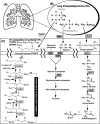In vivo evidence of Pseudomonas aeruginosa nutrient acquisition and pathogenesis in the lungs of cystic fibrosis patients
- PMID: 17724070
- PMCID: PMC2168270
- DOI: 10.1128/IAI.01807-06
In vivo evidence of Pseudomonas aeruginosa nutrient acquisition and pathogenesis in the lungs of cystic fibrosis patients
Abstract
One of the hallmarks of Pseudomonas aeruginosa infection in cystic fibrosis (CF) patients is very-high-cell-density (HCD) replication in the lung, allowing this bacterium to induce virulence controlled by the quorum-sensing systems. However, the nutrient sources sustaining HCD replication in this chronic infection are largely unknown. Here, we performed microarray studies of P. aeruginosa directly isolated from the lungs of CF patients to demonstrate its metabolic capability and virulence in vivo. In vivo microarray data, confirmed by real-time reverse transcription-PCR, indicated that the P. aeruginosa population expressed several genes for virulence, drug resistance, and utilization of multiple nutrient sources (lung surfactant lipids and amino acids) contributing to HCD replication. The most abundant lung surfactant lipid molecule, phosphatidylcholine (PC), induces key genes of P. aeruginosa pertinent to PC degradation in vitro as well as in vivo within the lungs of CF patients. The results support recent research indicating that P. aeruginosa exists in the lungs of CF patients as a diverse population with full virulence potential. The data also indicate that there is deregulation of several pathways, suggesting that there is in vivo evolution by deregulation of a large portion of the transcriptome during chronic infection in CF patients. To our knowledge, this is the first in vivo transcriptome analysis of P. aeruginosa in a natural infection in CF patients, and the results indicate several important aspects of P. aeruginosa pathogenesis, drug resistance, nutrient utilization, and general metabolism within the lungs of CF patients.
Figures




Similar articles
-
Use of a Multiplex Transcript Method for Analysis of Pseudomonas aeruginosa Gene Expression Profiles in the Cystic Fibrosis Lung.Infect Immun. 2016 Sep 19;84(10):2995-3006. doi: 10.1128/IAI.00437-16. Print 2016 Oct. Infect Immun. 2016. PMID: 27481238 Free PMC article.
-
Microevolution of Pseudomonas aeruginosa to a chronic pathogen of the cystic fibrosis lung.Curr Top Microbiol Immunol. 2013;358:91-118. doi: 10.1007/82_2011_199. Curr Top Microbiol Immunol. 2013. PMID: 22311171 Review.
-
Blocking phosphatidylcholine utilization in Pseudomonas aeruginosa, via mutagenesis of fatty acid, glycerol and choline degradation pathways, confirms the importance of this nutrient source in vivo.PLoS One. 2014 Jul 28;9(7):e103778. doi: 10.1371/journal.pone.0103778. eCollection 2014. PLoS One. 2014. PMID: 25068317 Free PMC article.
-
Iron acquisition by Pseudomonas aeruginosa in the lungs of patients with cystic fibrosis.Biometals. 2009 Feb;22(1):53-60. doi: 10.1007/s10534-008-9197-9. Epub 2009 Jan 7. Biometals. 2009. PMID: 19130260 Review.
-
Genotypic and phenotypic analyses of a Pseudomonas aeruginosa chronic bronchiectasis isolate reveal differences from cystic fibrosis and laboratory strains.BMC Genomics. 2015 Oct 30;16:883. doi: 10.1186/s12864-015-2069-0. BMC Genomics. 2015. PMID: 26519161 Free PMC article.
Cited by
-
Metabolic Mechanism and Physiological Role of Glycerol 3-Phosphate in Pseudomonas aeruginosa PAO1.mBio. 2022 Dec 20;13(6):e0262422. doi: 10.1128/mbio.02624-22. Epub 2022 Oct 11. mBio. 2022. PMID: 36218368 Free PMC article.
-
Pseudomonas aeruginosa Phosphate Transporter PitA (PA4292) Controls Susceptibility to Aminoglycoside Antibiotics by Regulating the Proton Motive Force.Antimicrob Agents Chemother. 2022 Dec 20;66(12):e0099222. doi: 10.1128/aac.00992-22. Epub 2022 Nov 8. Antimicrob Agents Chemother. 2022. PMID: 36346250 Free PMC article.
-
Metabolomics responses and tolerance of Pseudomonas aeruginosa under acoustic vibration stress.PLoS One. 2024 Jan 29;19(1):e0297030. doi: 10.1371/journal.pone.0297030. eCollection 2024. PLoS One. 2024. PMID: 38285708 Free PMC article.
-
Gallium disrupts bacterial iron metabolism and has therapeutic effects in mice and humans with lung infections.Sci Transl Med. 2018 Sep 26;10(460):eaat7520. doi: 10.1126/scitranslmed.aat7520. Sci Transl Med. 2018. PMID: 30257953 Free PMC article. Clinical Trial.
-
Challenges in using transcriptome data to study the c-di-GMP signaling network in Pseudomonas aeruginosa clinical isolates.FEMS Microbes. 2023 Jul 18;4:xtad012. doi: 10.1093/femsmc/xtad012. eCollection 2023. FEMS Microbes. 2023. PMID: 37564278 Free PMC article.
References
-
- Akasaka, T., M. Tanaka, A. Yamaguchi, and K. Sato. 2001. Type II topoisomerase mutations in fluoroquinolone-resistant clinical strains of Pseudomonas aeruginosa isolated in 1998 and 1999: role of target enzyme in mechanism of fluoroquinolone resistance. Antimicrob. Agents Chemother. 45:2263-2268. - PMC - PubMed
-
- Bernhard, W., J.-Y. Wang, T. Tschernig, B. Tummler, H. J. Hedrich, and H. von der Hardt. 1997. Lung surfactant in a cystic fibrosis animal model: increased alveolar phospholipid pool size without altered composition and surface tension function in cftrm1HGU/m1HGU mice. Thorax 52:723-730. - PMC - PubMed
-
- Bowton, D. L. 1999. Nosocomial pneumonia in the ICU—year 2000 and beyond. Chest 115:28S-33S. - PubMed
Publication types
MeSH terms
Substances
Grants and funding
LinkOut - more resources
Full Text Sources
Medical
Molecular Biology Databases

